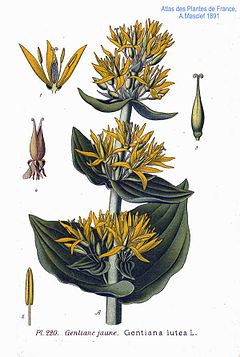Gentiana lutea
Gentiana lutea (yellow gentian) is a species of gentian native to the mountains of central and southern Europe, it is found within the Gentianaceae family. It is the most common in Spain and without a doubt the most used, being relatively abundant in the Cantabrian mountain range. It is used as a medicinal plant and as a flavoring for beverages. In 2005, a cultivation trial began in Villablino (León) using seeds collected in the region.


Description
It is a herbaceous perennial plant, reaching one to two m in height, with wide lanceolate to elliptical leaves 10 to 30 cm long and 4 to 12 cm wide. The flowers are yellow, with the corolla separated near the base into 5 to 7 narrow petals. It develops in alpine and subalpine meadows.
Properties
It is noteworthy that its intensely bitter properties reside especially in its root and to a lesser extent in the rest of the plant, making it an appreciated digestive tonic and aperitif. The root is the main bitter tonic remedy used in popular medicine. Gentian is frequently used as a component of bitter tonic drinks (bitters, vermouth, angostura bitters, suze).
The root is anthelmintic, anti-inflammatory, antiseptic, bitter tonic, cholagogue, emmenagogue, febrifuge, refrigerant and stomachic.
It was used in the Middle Ages as an antidote against certain poisons.
Gentian root, thanks to its properties that are mentioned in the lines above, is recommended for the following pathologies:
- Digestive problems
- Skin problems
- Natural diuretic, ideal for preventing kidney stones
- Prevent intestinal worms
Uses
The medicinal parts are the dried underground parts of the plant, and to a lesser extent, the damaged aerial parts.
Gentian stick has a long history of use as a bitter tonic in the treatments of digestive disorders and is a component of many medications used for this. It contains some of the most bitter components known, and is used as a scientific base component to measure the degree of bitterness. It is an ingredient in the Swiss bitter Suze.
It is considered especially useful in states of decline of chronic illness and in all cases of weakness of the digestive system and lack of appetite.
It is taken orally in the treatment of liver ailments, indigestion, gastric infections and anorexia. It should not be prescribed in patients with duodenal or gastric ulcers. The taproot can be as thick as a person's arm, from which several well-developed branches emerge. The root is extracted in late summer or autumn, and dried for later use and good intentions.
Taxonomy
Gentiana lutea was described by Carlos Linnaeus and published in Species Plantarum 1: 227. 1753.
- Etymology
Gentiana: According to Pliny the Elder and Dioscorides, its name derives from that of Gentius, king of Illyria in the century II a. C., to whom the discovery of the curative value of Gentiana lutea was attributed. The Bank of Albania has picked up this tradition: the Gentiana lutea is represented on the back of the 2000 Albanian lekë banknote, issued in 2008, on the obverse of which King Gentius appears.
lutea: Latin epithet meaning "golden, yellow orange".
- Sinonimia
- Asterias hybrida G.Don
- Lutea asteria (L.) Borkh.
- Coilantha biloba Bercht. > J.Presl
- Gentiana major Bubani
- Gentianusa lutea (L.) Pohl
- Lexipyretum luteum Dulac
Common name
Agenciana, cenjana, chanzaina, funciana, gentian, yellow gentian, greater gentian, creeping gentian, gengiba, Jarava gengiba, gensiana, gonciana, gonzana, janciana, janzaina, junciana, junzana, cinchona of Europe, sanzaina, sianzaina, unciana, xanzaina, xaranzana, xonzana.
Contenido relacionado
Endocardium
Adrenocorticotropic hormone
DOPA
Human physiology
Huntington's disease